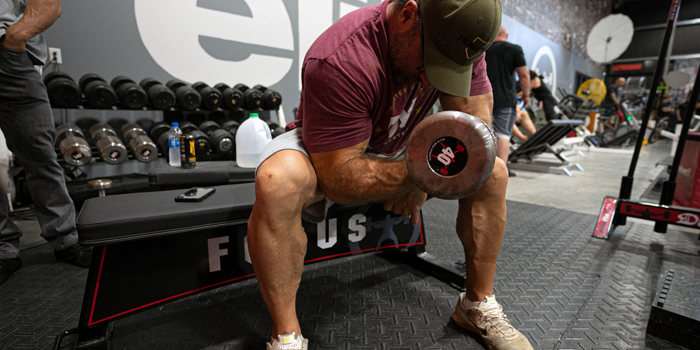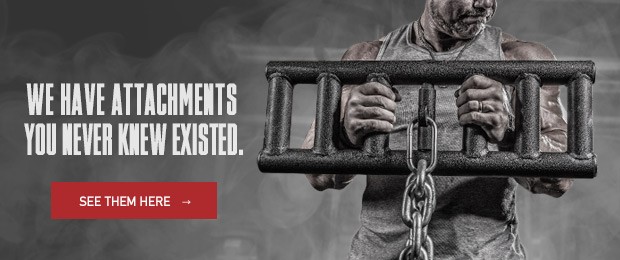
When it comes to athletic development, many coaches try to have an all-encompassing, balanced approach. They understand the importance of appropriate strength training, paired with solid movement and speed development.
Considering this hierarchy of training, those same coaches will scoff at emphasizing any direct arm training or isolation exercises included in a program.
Training has become a personal belief system for some. Where coaches and athletes take a tribal stance and think they have to choose between training options. Sumo or conventional? High bar or low bar? And more that flood social media comments.
When considering exercise selection, it isn’t about what is right versus wrong, but rather the most appropriate exercise for the individual. Also, what is the most effective means, with the lowest risk, to help serve that individual.
MORE: Arm Training for Strength Athletes
Excluding direct arm training from your athletes is a complete disservice to them physically and psychologically. It is extremely hypocritical to claim focus on the body as a whole while completely neglecting two of its limbs!
Athletes need to train arms for the following reasons:
- Confidence
- Health and durability
- Complete “functional” strength
- Building a healthy relationship with strength training
Confidence
The most important attribute that a strength coach can help an athlete build isn’t physically related to strength; it’s their confidence. This is often misunderstood, but confidence is the limiting factor for athletes who already have a firm grasp of their sport's physical and tactical/technical abilities.
I work primarily with younger high school athletes, and I cannot tell you how many times I’ve seen a young athlete's, females included, mindset change on how they view themselves when they begin to look the part of being strong.
I’m sure many of you reading this have a similar past as mine, and this is what got us into the field in the first place— either lifting to improve at a sport maybe we particularly weren’t very good at or if just to change our bodies to better our lives. The weight room helped build us that confidence.
Health and Durability
If the plan is to train athletes to be as durable and robust as possible, direct arm training will be necessary. Areas such as the wrists and elbows are susceptible to overuse injuries and building some support in those areas will give your athletes some insurance. Especially in overhead sports such as baseball, volleyball, and combative sports such as wrestling, boxing, and football, these injuries are more common and need to be addressed. We will never be able to prevent injuries, but we can certainly better equip our athletes for the day-to-day stressors of the sport!
Ensure to mix up the variations of the exercises regularly to avoid issues such as tendonitis. While doing this and occasionally performing high rep finishers to complete workouts can lead to healthy joints and stabilizer muscles.
An example of this would be finishing a session with one set of 100 reps of movements such as triceps press downs or light dumbbell curls. Completing as quickly as possible with quality movement and range, resting no longer than 20 seconds between breaks.
Complete “Functional” Strength
Functional strength gets thrown around too much in the training space and is typically out of context. I consider functional strength to be the strength allowing you to perform better. Nothing other than that direct task should be considered functional. So, the big three (squat, bench press, and deadlift) is extremely functional.
Then we have exercises to help bring up weak points or areas to assist with our functional strength. The muscles of the arms are needed to efficiently press, pull, and maintain grip for extended periods of time. Many sports require these actions listed to be performed in some capacity, so they should not be neglected. Some sports may require them less, but our training program should match that requirement.
Compound exercises such as the close grip barbell bench press, chin-ups, overhead press, and bent-over row will lead indirectly to this and should make up the bulk of our training. However, isolation exercises can bring up additional weak points and areas that may need more overall attention.
Including a few additional sets of triceps extensions and various curls is a start. Along with strengthening the grip perform various holds for maximum time, carries, and train with implements such as Fat Gripz to challenge those common bicep and triceps exercises to get more out of those movements.
Build a Healthy Relationship with Strength Training
Getting into training, while exciting, can also be a scary time. When new to the weight room, athletes can be uncertain and uncomfortable at first. This is understandably normal. Using simple things such as arm form or arm finishers can serve as the cherry on top for the training session. This practice can help begin forming the bridge for that individual to desire more out of the weight room and build a healthy relationship with strength training.
It may come as a surprise, but not all athletes are obsessed with the weight room like we are. Including direct arm training could be the only reason some of them look forward to the session ahead. While periodization and proper execution of exercises are important, there also has to be a fun factor, and we should be the best part of our athlete’s day!
It’s our jobs as coaches to help our athletes set healthy and appropriate expectations with strength training. I stress to all my athletes that regardless of what level they finish playing at, high school varsity, college, or even professionally, their athletic careers will finish one day. And once it is finished, they will still need to live a healthy, physically challenging life. Having a healthy, balanced relationship with strength training is going to be the first requirement.
To sum it up, the simple bicep curls and tricep dips hold more weight in our program than we give credit. While not the centerpiece for the program, it is a solid addition to include to help lead to an increase in our athlete’s confidence, strength, and long-term health. Along with this training, the arms can be the bridge they need to start this lifelong journey with strength training.
Brandon Holder is a sports performance coach at FASST Sports Performance in Winchester, Virginia. He works with athletes of all ages and levels, ranging from nine-year-olds to Division I athletes. Along with that, he is the assistant strength and conditioning coach at Shenandoah University. Prior to FASST, Brandon was an assistant strength and conditioning coach at Bridgewater College, where he worked with more than 20 sports. He obtained his bachelor's degree in health and exercise science from Bridgewater College and holds CSCS, USAW, and FMS certifications as well.











1 Comment